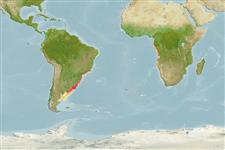Environment: milieu / climate zone / depth range / distribution range
Ecología
marino demersal; rango de profundidad 10 - ? m (Ref. 27363). Subtropical; 1°S - 46°S, 68°W - 14°E
Eastern Atlantic: known only from larvae collected in the southern Gulf of Guinea from Annobon, Equatorial Guinea to Mossamedes (Moçâmedes), Angola. Western Atlantic: Rio de Janeiro, Brazil to San Jorge Gulf, Argentina (Ref. 86990).
Tamaño / Peso / Age
Maturity: Lm ? range ? - ? cm
Max length : 112 cm TL macho / no sexado; (Ref. 57911)
Short description
Morfología | Morfometría
Pectorals small and fan-shaped (Ref. 27363).
Found in shallow waters of the continental shelf (Ref. 27363). Feeds on fishes, shrimps, crabs and mollusks.
Life cycle and mating behavior
Madurez | Reproducción | Puesta | Huevos | Fecundidad | Larva
Specimens captured in deep waters of Brazil had ovaries occupying the whole abdominal cavity with scarce adipose tissue and degraded body indicative of semelparity (Ref. 92882).
Smith, D.G., 1990. Congridae. p. 156-167. In J.C. Quero, J.C. Hureau, C. Karrer, A. Post and L. Saldanha (eds.) Check-list of the fishes of the eastern tropical Atlantic (CLOFETA). JNICT, Lisbon; SEI, Paris; and UNESCO, Paris. Vol. 1. (Ref. 4453)
IUCN Red List Status (Ref. 130435)
Threat to humans
Harmless
Human uses
Pesquerías: escaso valor comercial
Más información
ReferenciasAcuiculturaPerfil de acuiculturaRazasGenéticaElectrophoresesheritabilidadEnfermedadesProcesamientoNutrientsMass conversion
ColaboradoresImágenesStamps, Coins Misc.SonidosCiguateraVelocidadTipo de nataciónSuperficie branquialOtolitosCerebrosVisión
Herramientas
Special reports
Download XML
Fuentes de Internet
Estimates based on models
Preferred temperature (Ref.
123201): 11.8 - 24.9, mean 15.8 °C (based on 168 cells).
Phylogenetic diversity index (Ref.
82804): PD
50 = 0.5000 [Uniqueness, from 0.5 = low to 2.0 = high].
Bayesian length-weight: a=0.00043 (0.00024 - 0.00076), b=3.23 (3.08 - 3.38), in cm total length, based on LWR estimates for this species & Genus-body shape (Ref.
93245).
Nivel trófico (Ref.
69278): 3.7 ±0.59 se; based on food items.
Generation time: 7.3 ( na - na) years. Estimated as median ln(3)/K based on 1
growth studies.
Resiliencia (Ref.
120179): Medio, población duplicada en un tiempo mínimo de 1.4-4.4 años (Assuming tm<5).
Fishing Vulnerability (Ref.
59153): High vulnerability (61 of 100).
Climate Vulnerability (Ref.
125649): Moderate vulnerability (38 of 100).
Nutrients (Ref.
124155): Calcium = 44.1 [26.7, 86.9] mg/100g; Iron = 0.851 [0.485, 1.384] mg/100g; Protein = 18.6 [15.8, 21.4] %; Omega3 = 0.3 [0.1, 0.8] g/100g; Selenium = 52.3 [28.1, 102.7] μg/100g; VitaminA = 7.4 [2.2, 24.5] μg/100g; Zinc = 0.556 [0.410, 0.786] mg/100g (wet weight);
